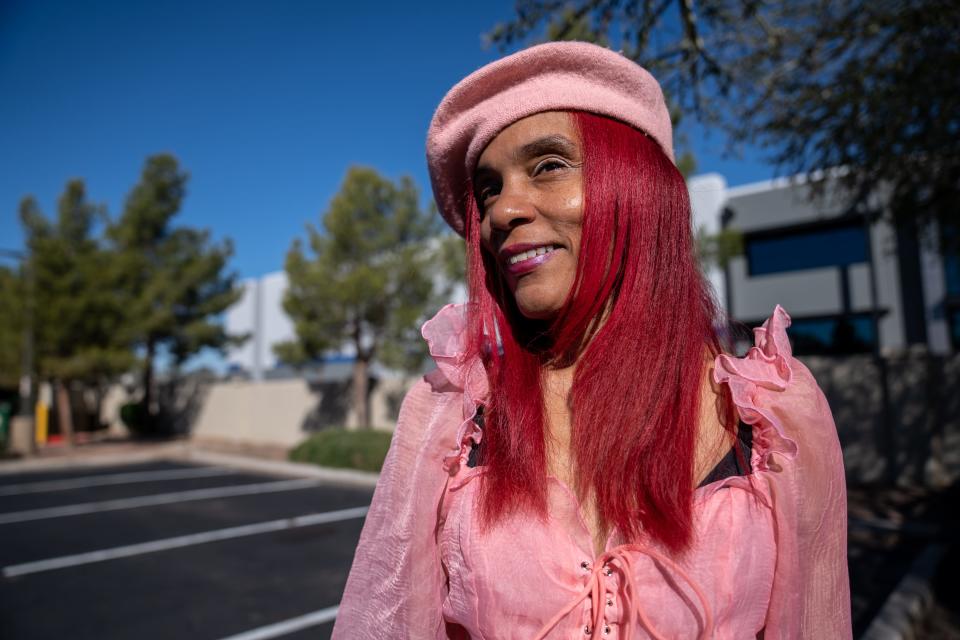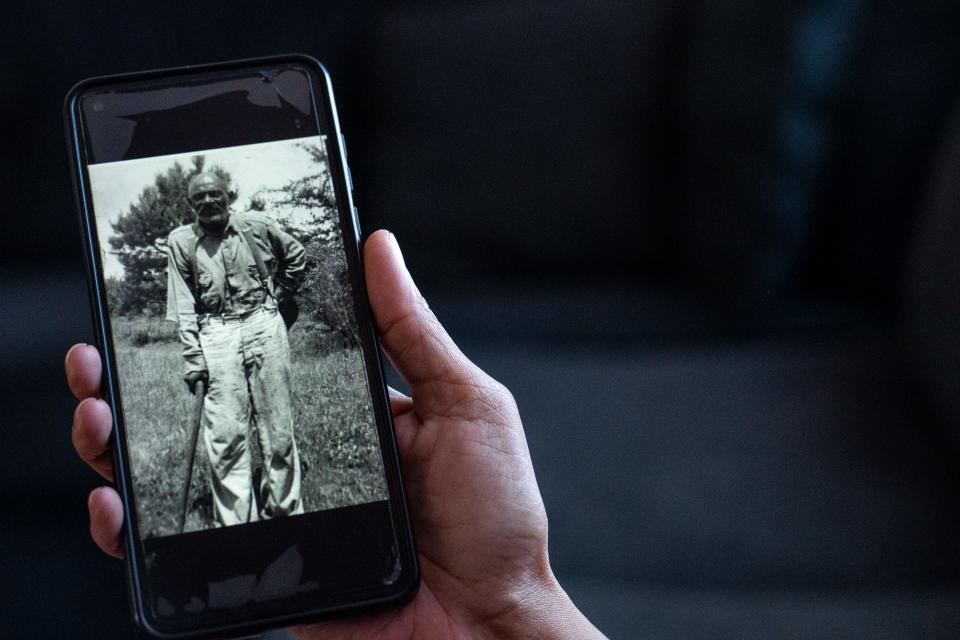Quest to right an injustice: How a DNA test revealed the truth of this Peoria woman's ancestry
As a light-skinned African American woman, Candice Hammons was always curious about her roots. She also knew little about her mother's side of the family.
So, in 2018, Hammons paid $99 for a DNA test through the genealogy website Ancestry. The results arrived six weeks later, revealing a personal history that Hammons shares with many descendants of people brought to the U.S. in bondage from Africa and sold into slavery.
The DNA results also led to the revelation of a cruel injustice that Hammons is determined to undo.
The analysis of her DNA showed that Hammons is a nearly equal mixture of African and European ethnicity. About half of her genes can be traced to Cameroon, Congo, Nigeria, Senegal, the Ivory Coast, and other countries in Africa, while the other half can be traced to many regions of Europe, among them England, northwest Europe, Eastern Europe, Ireland, France and Spain. Some of her ancestors also came from Cyprus in the Mediterranean.
By continuing to probe into her background, Hammons discovered many living relatives she did not previously know, including many white relatives. Some have ignored Hammons' attempts to reach out. Others have now become allies in her quest for justice.
That quest for justice is rooted in her genealogical journey's most surprising discovery.
On her mother's side, Hammons learned that her third great-grandfather, Albartis Arnwine, was a white enslaver who, in the mid-1800s, owned several enslaved Black women, including one named Gracie Arnwine, who is Hammons' third great-grandmother. Albartis Arnwine and Gracie Arnwine produced six children.
Before he died, Albartis Arnwine wrote a will granting freedom to Gracie Arnwine, her children and all the enslaved people he owned — nearly two dozen people. In the will, Albartis Arnwine also said he wanted the proceeds from the sale of his property, which included 900 acres in Texas, to be left to them.
Hammons believes the will is a testament to the genuine affection, if not love, that Albartis Arnwine had for Gracie and their children.
Rather than contempt for her third great-grandfather, Hammons holds him in high regard because of the will he wrote.

"It made me have love for him," said Hammons, 51, a Peoria resident. "We really feel like he is our hero."
But the wishes Albartis Arnwine wrote in his will were never carried out.
After he died in 1855, Arnwine's white relatives contested the will. Gracie Arnwine and all of the enslaved people Albartis Arnwine had owed were divided and sold or became the property of other enslavers, according to family history Hammons and other members of the Arnwine family have pieced together from historical records.
One of those records is an account given by Sterlin Arnwine. When he was 94, he took part in the federal Slave Narrative Project, a series of 2,300 interviews of former enslaved people conducted in the 1930s. Sterlin Arnwine was the son of Minne Arnwine, one of four enslaved women Albartis Arnwine owned.
"When Mr. Arnwine died, before the (Civil) War, he made a will in which he gave his property to his slaves, the Negro women," according to Sterlin Arnwine's account complied in the book, "The American Slave: A Composite Autobiography."
But court records Hammons and other Arnwine family members have compiled show the Arnwine children may have remained enslaved until 1859, when a judge may have granted them their freedom, or they may not have been freed until after the Civil War ended in 1865.
It is known that none of the enslaved Arnwines ever received any share of the property left to them by Albartis Arnwine in his will.
"The Negro women never did get the 900 acres that Mr. Arnwine gave them," said Sterlin Arnwine. "I knows that I still have a share in that land, but (it) takes money nowadays in case in court."
And that is the injustice that Hammons is trying to undo, all as a result of that DNA test in 2018.
After connecting with other members of the Arnwine family through Ancestry, Hammons and several of her newly found relatives have banded together in the hope of taking legal action to reclaim the land or receive compensation. They have shared their story on Change.org and created a GoFundMe account to raise $20,000 to hire a lawyer willing to pursue a land claim.
Meet a woman: who runs Phoenix's specialty court for people experiencing homelessness
Professor: People who could not gain freedom unable to inherit property
It's not unusual for African Americans who are the descendants of enslaved people to learn they have both African and European ancestry through DNA tests, said Calvin Schermerhorn, an Arizona State University history professor and author of "Unrequited Toil: A History of United States Slavery."
The DNA tests often only confirm what they already suspected, Schermerhorn said.
It was not unusual during slavery for white enslavers to have children with enslaved Black women, often through force or in secret, Schermerhorn said.
Because of the imbalance of power between white enslavers and enslaved Black women, it's difficult, however, to know whether sexual relations between the two were the result of genuine affection, he said.
"The power asymmetry is so great that what counts as affection, right? Where does affection stop and rape start? That's the problem," Schermerhorn said. "There are many more cases of sexual assault and rape than there are of genuine affection."
But there can be found in the historical record many examples of the children of enslaved people being told they were inheriting property, which could be evidence that their enslavers truly cared for them, Schermerhorn said.
"This happened often enough for records to be there. There are parallel stories" to that of the Arnwines, Schermerhorn said.
It's not surprising that the Arnwines never inherited any of the property Albartis Arnwine bequeathed to them in his will. Rarely did that happen, Schermerhorn said.
Manumission laws, the act of freeing enslaved people from their enslavers, varied from state to state. Many states had strict manumission laws, which made it difficult for enslavers to grant freedom to enslaved people they owned, Schermerhorn said. And without freedom, enslaved people could not inherit property, he said.

Some states required enslaved people who gained their freedom through manumission to leave the state. That also made it virtually impossible for them to claim any property through inheritance, he said.
What's more, enslaved people who tried to fight for inheritances in court were unlikely to win since judges would have almost certainly sided with white relatives, Schermerhorn said.
"Even in cases where the law would clearly be on the side of African American plaintiffs, courts routinely ignored their pleas or just made some summary judgment or refused to hear a case that would benefit them," Schermerhorn said.
A reporter with Houston television station KHOU 11 covered Hammons' story and traveled to Jacksonville in Cherokee County, Texas. Using old maps, the reporter discovered that much of the land Albartis Arnwine willed to the Arnwines may now sit under a human-made lake.

Schermerhorn believes it will be difficult for Hammons and other Arnwine ancestors to reclaim the land they were denied in Texas. They will need a legal expert who can sort through decades of laws and legal cases going back to before the Civil War in Texas.
"It's very difficult to reverse property transfers and ownership down across generations," Schermerhorn said.
Hammons' story is representative of growing numbers of African Americans discovering their ties to white slaveholders through DNA tests and making claims to be included in their families. Until the 1990s, the established family of Thomas Jefferson, one of the Founding Fathers and the third U.S. president, denied he had children with Sally Hemings, an enslaved woman, until DNA evidence proved the link in 1998.
"After the revelations came out — the DNA test that linked Jefferson to Sally Hemings and her offspring — the descendants of Jefferson through Hemings made a claim to be a part of the Thomas Jefferson Descendants Association," Schermerhorn said.
The revelation that Hammons' ancestors appear to have been denied land willed to them by a wealthy slaveholder also adds to a growing push for reparations to help make up for the wealth Black descendants of enslaved people lost, Schermerhorn said.
'I remember too': Meet the group resurrecting lost history of Phoenix's bulldozed barrios
Will direct sale of land first, with proceeds to relocate enslaved people
The Arnwines are now scattered around the country.
Janice Arnwine Bryant, 66, of Fayetteville, Georgia, is a descendent of Winnie Arnwine, one of the women Albartis Arnwine owned. She is a retired high school teacher and amateur genealogist who has been researching Arnwine family history since she was 19.
Albartis Arnwine was born in 1776 in Tennessee, Bryant said. He fled to Texas after neighbors in Tennessee shot at his house over his favorable treatment of enslaved people, Bryant said. Albartis Arnwine may even have killed one of the neighbors in defense, Bryant said.
Albartis Arnwine settled in Jacksonville, Texas, which is about 115 miles southeast of Dallas. There, he owned property and several enslaved women he brought from Tennessee. Bryant has a copy of the will he signed on June 15, 1855, before he died.
In the will, Albartis Arnwine lists the names of 22 enslaved people he owned.
"All of the above negroes I do will to be free manumitted and discharged from all manner of servitude .... forever," the will states.
The will goes on to state that all of his property and chattel should be sold and that the money should be used to relocate and settle the people he enslaved and then "equally divided amongst" them.
The way Albartis Arnwine wrote the will, instructing executors to sell the land first, suggests he genuinely wanted the enslaved people he owned to benefit from the property, said Schermerhorn, the ASU professor. Albartis Arnwine most likely would have known that just willing the land to them would not be successful, he said.
Hammons and the other relatives said they don't want to get rich. If they succeed in their land claim, they may want to use the land or compensation to build a community center or create an endowment for educational scholarships or house down payments.
"I just want to honor my great-grandmother," said Mary Tucker, 45, a nursing administrator who lives in Los Angeles and is a descendant of Albartis Arnwine and Gracie Arnwine. She discovered she is related to Hammons and other Arnwine descendants through Ancestry.
Extended family members connect via Facebook, Ancestry
Terrie Arnwine Breedlove, 56, a former hospital administrator, lives in Bellevue, Illinois. She is from the white side of the Arnwine family.
In the mid-1990s, she helped care for her aging grandfather, Joe Hoyt Arnwine, who was living in an assisted living facility in Mt. Pleasant, Texas, at the time.
Before he died, her grandfather shared a family secret the Arnwine family didn't like to discuss.
"He had a sit down with me and told me he wanted to tell me the 'whole story,' and I didn't know what he meant by the 'whole story,'" Breedlove said.
Breedlove discovered she had Black relatives who were the descendants of Albartis Arnwine.
Breedlove said she was "unfazed" by the revelation that she had Black relatives and began trying to connect with as many of them as possible through Facebook.
"I literally search every day," Breedlove said. "I grew up with one aunt and three cousins, and we didn't spend a lot of time together ever. And being someone who is very sociable, and my sister and my brother ... we craved finding more people from our family. We don't care what they look like."
Then, a few years ago, she heard from Hammons through Ancestry and discovered Hammons is one of her extended cousins.
Breedlove is now involved in the Arnwine family effort to seek justice for the Black side of the Arnwine family.
"I feel like it's an insult for them to have not received" the property left to them, Breedlove said.
The descendants of Albartis and Gracie Arnwine are planning a reunion in June in Los Angeles. They plan to wear T-shirts that say "Justice for the Arnwines."
It won't be a typical family reunion. But it will be no less special.
"We are so excited to get to finally meet each other in person instead of on the phone or on the internet," Hammons said.
Reach the reporter at daniel.gonzalez@arizonarepublic.com.
This article originally appeared on Arizona Republic: Candice Hammons' story: undoing an injustice found in family roots

